 I'll tell you one thing. After today we won't complain so much when someone steals a couple of our towels. 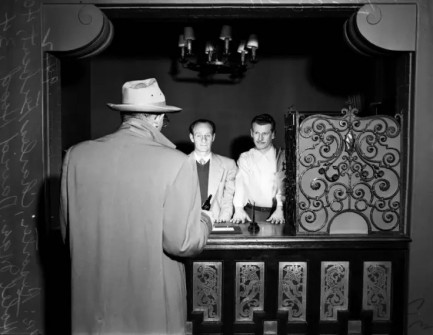 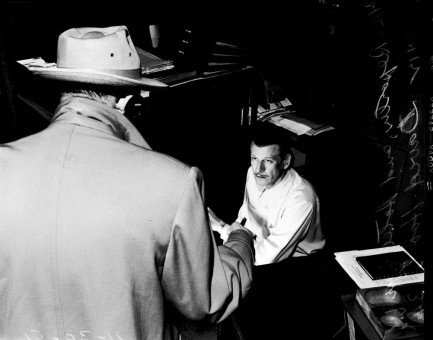
The two photos above show an LAPD detective and two witnesses re-enacting a robbery (notice the detective is aiming a gun in the top photo) that occurred today in 1951 at the Garden of Allah Hotel on Sunset Boulevard. Two gunmen had gotten away earlier in the day with a bundle of cash. Newspaper accounts differ about how much. The San Bernadino County Sun, in its evening edition published later, pegged the amount at $1,073 ($12,275 today), but the Los Angeles Times morning edition printed the next day claimed it was $500 ($5,731). The Times is probably a more reliable source, and with more time to get the amount right we'd tend to think its report is correct, but $500 is a conveniently round number, whereas the $1,073 reported by the Sun is very specific. Either way, we imagine the terrified hotel employees surrended every dollar on hand.
The reason the story caught our eye, though, is because the Garden of Allah was one of the most famous hotels in Los Angeles at the time. The Spanish revival complex consisting of a main building, villas, restaurant, bar, pool, and landscaped grounds, opened in 1927 and quickly became a favorite stopover for Tinseltown glitterati. Everyone from Lauren Bacall to Orson Welles spent time or stayed there, and the place was described by one resident as in “continual tumult” because of all the intrigues, disturbances, and minor scandals. But all of its celebrity history and architectural significance amounted to nothing among the ranks of those who sought so-called progress, because like so many other Hollywood landmarks, this iconic property fell to the wrecking ball when it was demolished in 1959 to make way for a bank.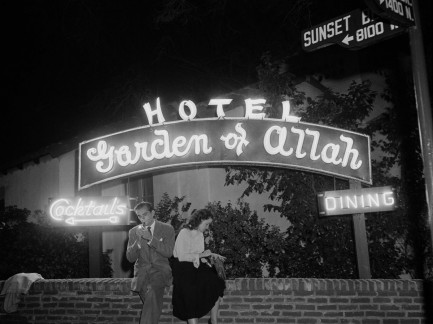 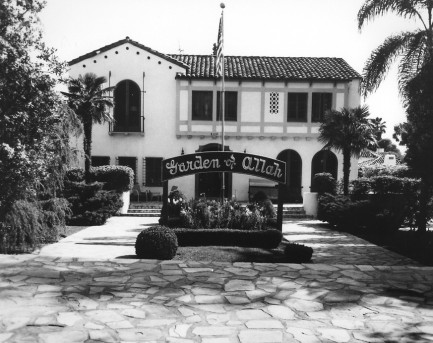 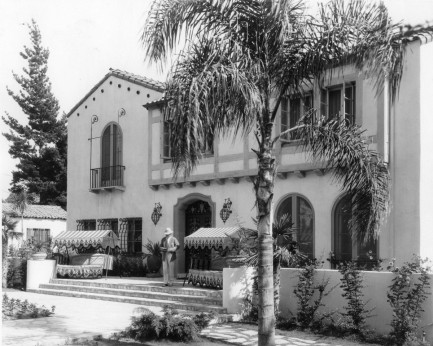 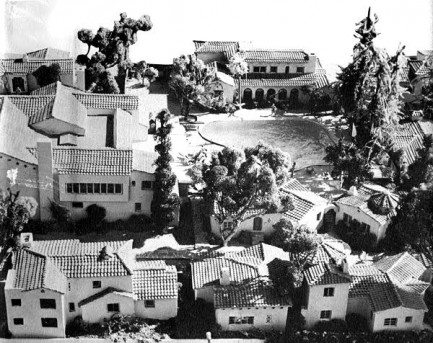
 If I can't live with you, you can't live without me. 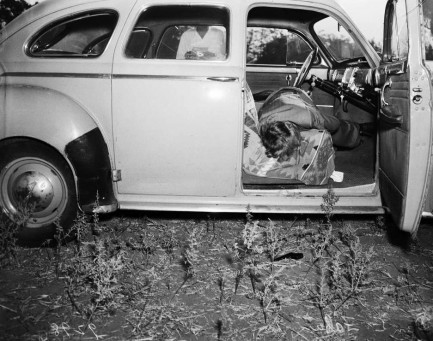
Seventy-three-year old Dan E. Fabun lies dead on the front seat of his car near Cardiff Avenue in San Bernadino, California. Fabun had separated from his sixty-six-year old wife Lula Fabun, but was at the house they once shared discussing its sale. But he had no intention of selling the house. Instead, he pulled a .32 caliber automatic pistol from his pocket and fired a volley of shots. One missed. One hit Lula in the torso, and another entered her right cheek and exited her left ear. Lula's unlucky brother-in-law was there too, and he was felled by a fourth bullet in the stomach. While lying wounded in the street, he saw Dan Fabun put the gun to his own head and pull the trigger, with a click resulting. Fabun then leaped into his car and drove off. Not more than a mile away he veered off the road, through a wire fence, and into a field, where police later found him in the condition you see above. He had drunk a deadly poison, and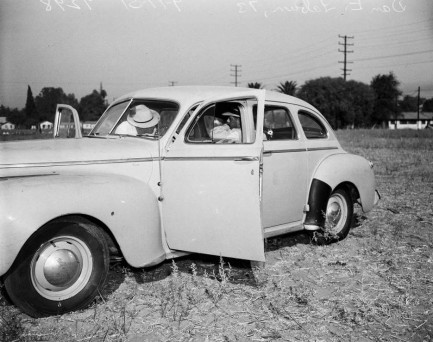 succumbed almost immediately. He carried two notes—one explaining his funeral arrangements, and the other explaining his reasoning for what he did. “I'm too old to live alone,” he wrote. And apparently, too unwilling to die alone. Today, 1951. succumbed almost immediately. He carried two notes—one explaining his funeral arrangements, and the other explaining his reasoning for what he did. “I'm too old to live alone,” he wrote. And apparently, too unwilling to die alone. Today, 1951.
 You know baby, driving is a serious game. 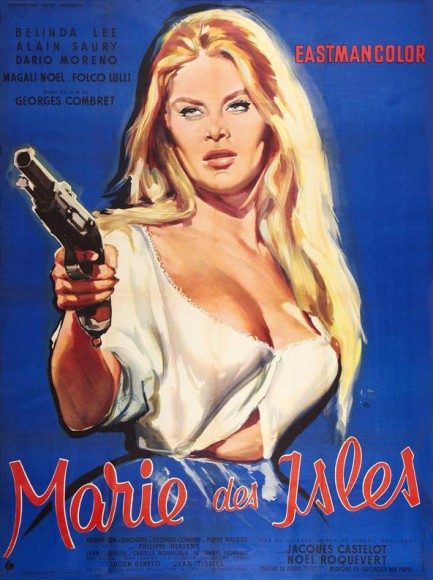
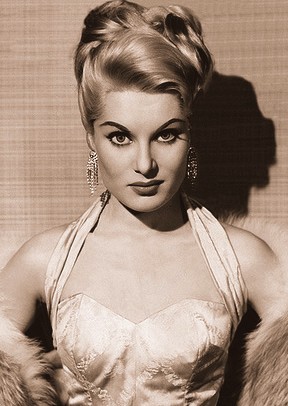 Marie des Isles, aka Marie of the Isles, isn’t really a pulp style movie. It’s a swashbuckler set in 1635, with pirates and swords and elaborate hats. However it has this killer poster, made for its January 1960 release, and it stars British actress Belinda Lee, she of the famously sculpted cheekbones and hawk eyebrows. Lee took European cinema by storm in the late 1950s, but like James Dean and Soledad Miranda, her career and life ended abruptly in an automobile accident. It happened in March 1961 during a trip from Las Vegas to Los Angeles, when a car in which she was a passenger blew a tire and flipped on a winding road near San Bernadino. Lee was thrown from the vehicle and was alive when the highway patrol arrived, but with a fractured skull and broken neck, she didn’t last long. She died in the arms of a California police officer who said she was the most beautiful thing he’d ever seen. She was twenty-seven. Marie des Isles, aka Marie of the Isles, isn’t really a pulp style movie. It’s a swashbuckler set in 1635, with pirates and swords and elaborate hats. However it has this killer poster, made for its January 1960 release, and it stars British actress Belinda Lee, she of the famously sculpted cheekbones and hawk eyebrows. Lee took European cinema by storm in the late 1950s, but like James Dean and Soledad Miranda, her career and life ended abruptly in an automobile accident. It happened in March 1961 during a trip from Las Vegas to Los Angeles, when a car in which she was a passenger blew a tire and flipped on a winding road near San Bernadino. Lee was thrown from the vehicle and was alive when the highway patrol arrived, but with a fractured skull and broken neck, she didn’t last long. She died in the arms of a California police officer who said she was the most beautiful thing he’d ever seen. She was twenty-seven.
|
 |

The headlines that mattered yesteryear.
2003—Hope Dies
Film legend Bob Hope dies of pneumonia two months after celebrating his 100th birthday. 1945—Churchill Given the Sack
In spite of admiring Winston Churchill as a great wartime leader, Britons elect
Clement Attlee the nation's new prime minister in a sweeping victory for the Labour Party over the Conservatives. 1952—Evita Peron Dies
Eva Duarte de Peron, aka Evita, wife of the president of the Argentine Republic, dies from cancer at age 33. Evita had brought the working classes into a position of political power never witnessed before, but was hated by the nation's powerful military class. She is lain to rest in Milan, Italy in a secret grave under a nun's name, but is eventually returned to Argentina for reburial beside her husband in 1974. 1943—Mussolini Calls It Quits
Italian dictator Benito Mussolini steps down as head of the armed forces and the government. It soon becomes clear that Il Duce did not relinquish power voluntarily, but was forced to resign after former Fascist colleagues turned against him. He is later installed by Germany as leader of the Italian Social Republic in the north of the country, but is killed by partisans in 1945.
|

|
|

It's easy. We have an uploader that makes it a snap. Use it to submit your art, text, header, and subhead. Your post can be funny, serious, or anything in between, as long as it's vintage pulp. You'll get a byline and experience the fleeting pride of free authorship. We'll edit your post for typos, but the rest is up to you. Click here to give us your best shot.

|
|









 succumbed almost immediately. He carried two notes—one explaining his funeral arrangements, and the other explaining his reasoning for what he did. “I'm too old to live alone,” he wrote. And apparently, too unwilling to die alone. Today, 1951.
succumbed almost immediately. He carried two notes—one explaining his funeral arrangements, and the other explaining his reasoning for what he did. “I'm too old to live alone,” he wrote. And apparently, too unwilling to die alone. Today, 1951.

 Marie des Isles, aka Marie of the Isles, isn’t really a pulp style movie. It’s a swashbuckler set in 1635, with pirates and swords and elaborate hats. However it has this killer poster, made for its January 1960 release, and it stars British actress Belinda Lee, she of the famously sculpted cheekbones and hawk eyebrows. Lee took European cinema by storm in the late 1950s, but like James Dean and Soledad Miranda, her career and life ended abruptly in an automobile accident. It happened in March 1961 during a trip from Las Vegas to Los Angeles, when a car in which she was a passenger blew a tire and flipped on a winding road near San Bernadino. Lee was thrown from the vehicle and was alive when the highway patrol arrived, but with a fractured skull and broken neck, she didn’t last long. She died in the arms of a California police officer who said she was the most beautiful thing he’d ever seen. She was twenty-seven.
Marie des Isles, aka Marie of the Isles, isn’t really a pulp style movie. It’s a swashbuckler set in 1635, with pirates and swords and elaborate hats. However it has this killer poster, made for its January 1960 release, and it stars British actress Belinda Lee, she of the famously sculpted cheekbones and hawk eyebrows. Lee took European cinema by storm in the late 1950s, but like James Dean and Soledad Miranda, her career and life ended abruptly in an automobile accident. It happened in March 1961 during a trip from Las Vegas to Los Angeles, when a car in which she was a passenger blew a tire and flipped on a winding road near San Bernadino. Lee was thrown from the vehicle and was alive when the highway patrol arrived, but with a fractured skull and broken neck, she didn’t last long. She died in the arms of a California police officer who said she was the most beautiful thing he’d ever seen. She was twenty-seven. 



































































